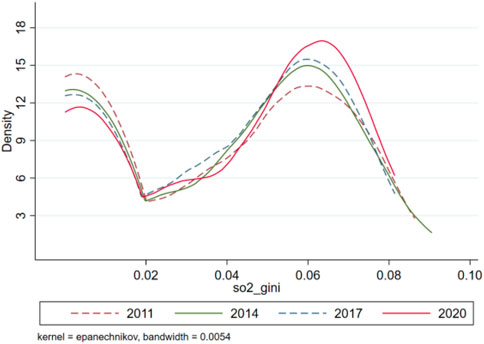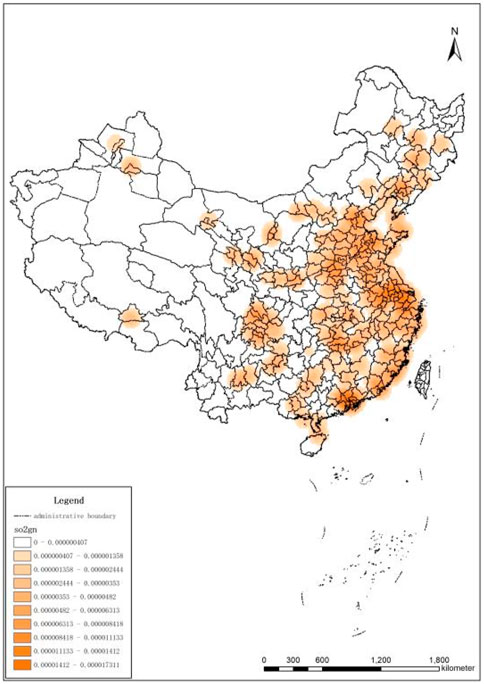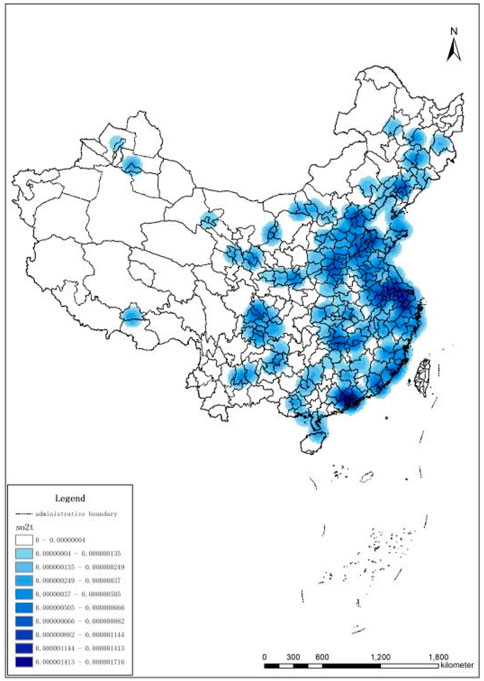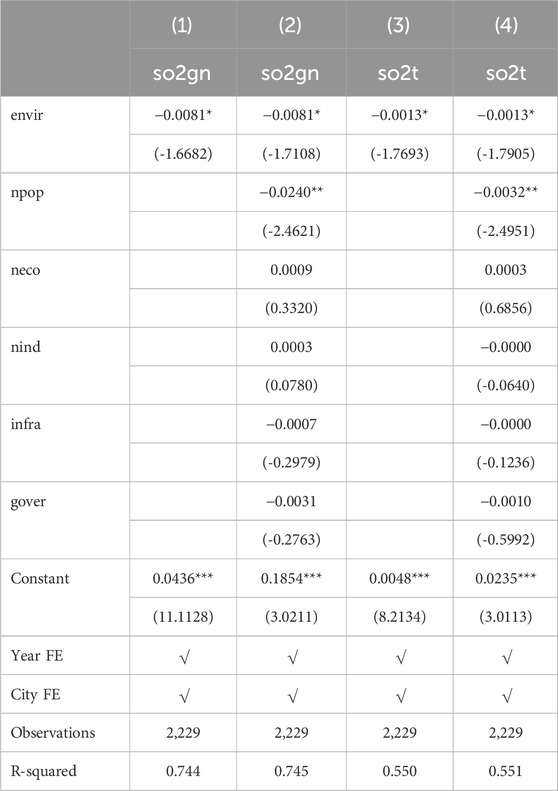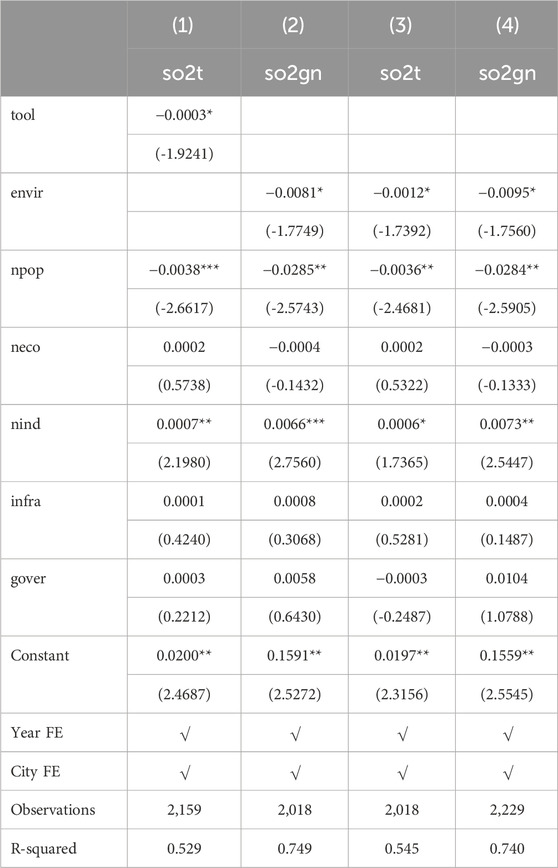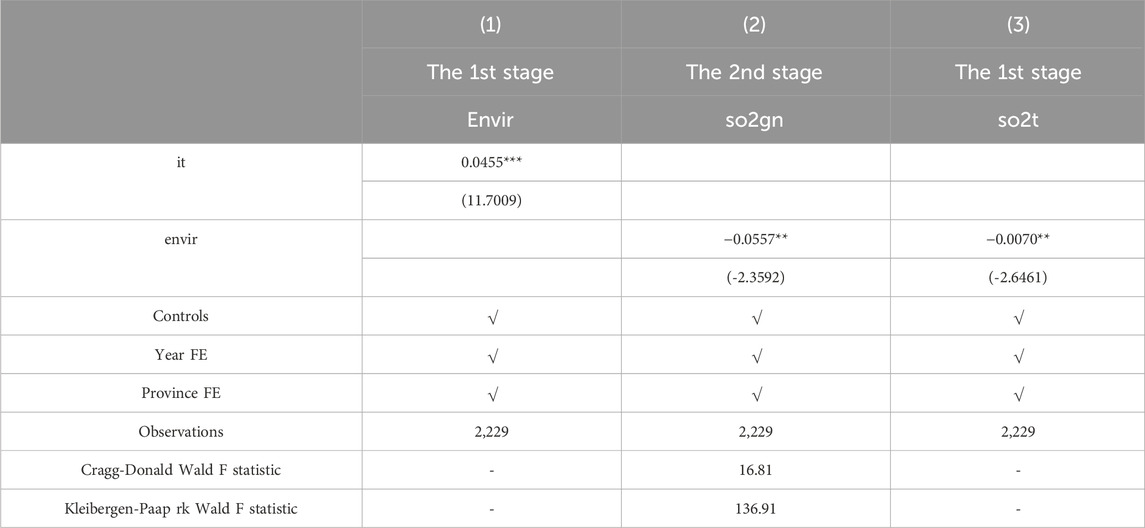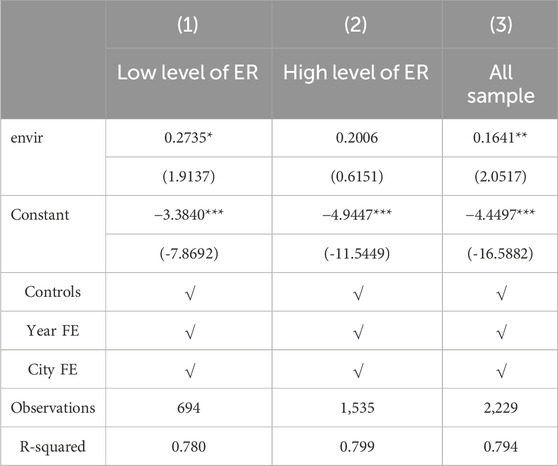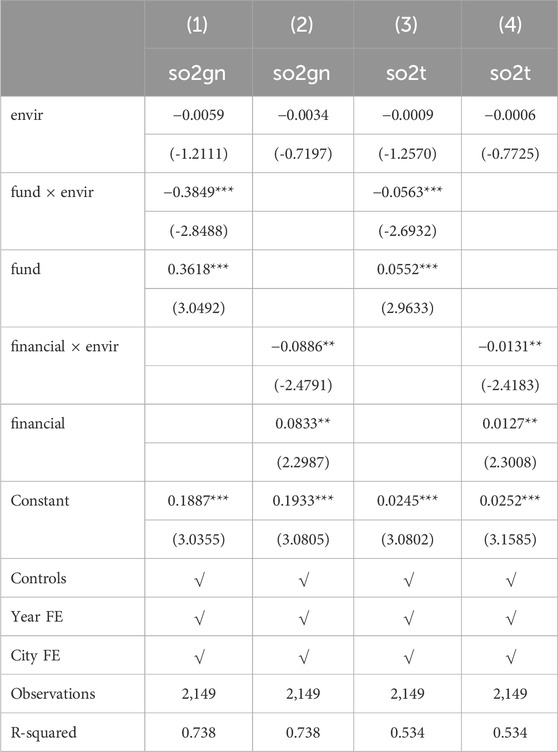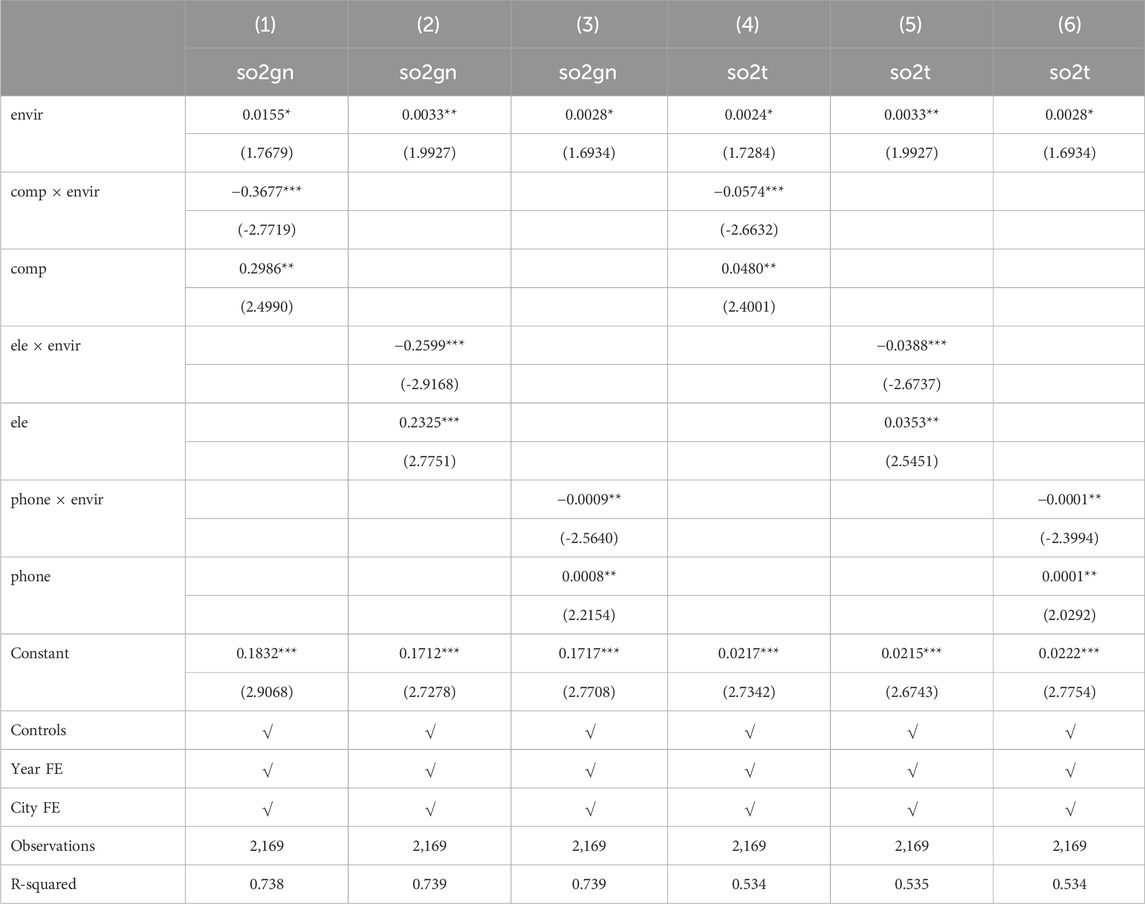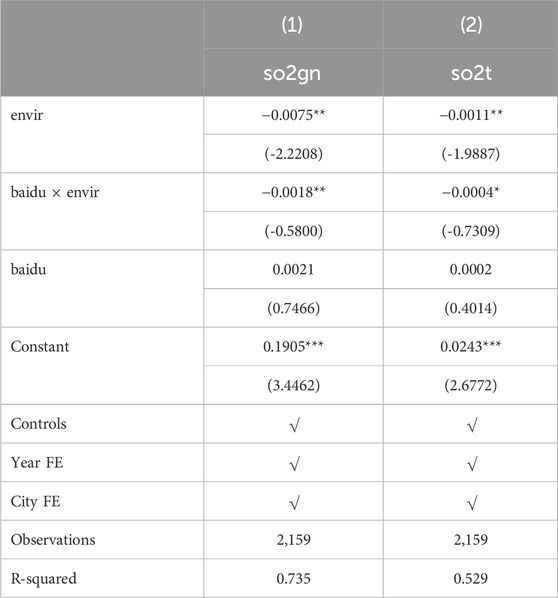- 1School of Management, Nanjing University of Posts and Telecommunications, Nanjing, China
- 2Jiangsu Maritime Institute, Nanjing, Jiangsu, China
Introduction: Environmental issues are related to the physical health and welfare level of all human beings, and the mandatory and dominant nature of environmental regulation (ER) effectively solves the difficult problem of unequal environmental obligations and gives impetus to improving environmental equality.
Methods: Therefore, based on a sample of 238 prefecture-level cities in China between 2011 and 2020, this paper empirically examines the mechanism and effect of ER intensity on environmental fairness using the Gini coefficient and the Theil index. In addition, this paper further tests the mechanisms of mediating influence and moderating effect of ER on environmental equality.
Results: The results of the study found that (1) On the basis of mitigating endogenous problems such as adopting instrumental variable strategies, the increase in the intensity of ER has a significant contribution to the realization of environmental equality. (2) ER contributes to the realization of environmental equality through the green innovation transformation effect, which is more pronounced in innovative regions. (3) The level of development of green finance and the digital economy, as an important instrumental approach to promoting sustainable development, can strengthen the path of environmental policy to mitigate environmental inequality.
Discussion: This paper provides suggestions and insights for promoting the implementation of government environmental policies, enhancing the digital transformation of economic development, and promoting the construction of a society-wide green equality system.
1 Introduction
Ecological environment is the basic requirement for realizing green and low-carbon development of the economy, and it is a public product enjoyed by everyone, and the improvement of environmental quality has a real bearing on the quality of life of all human beings (Wei et al., 2024). With the increase in the importance of environmental protection issues, the transformation of the economic growth model to an environmentally friendly one, and the green elements injecting new kinetic energy into the world’s economic vitality, green sustainability has become one of the themes of economic development in the current era (Zhi et al., 2022). However, due to objective factors such as geographic location and natural disasters, and subjective factors such as inadequate environmental monitoring and insufficient government attention to environmental equality issues, phenomena affecting environmental equality such as uneven distribution of pollution, inequitable access to resources, and environmental justice issues still exist objectively (Wu et al., 2024). From an international perspective, the number of threatened animal species is increasing and the number of renewable resources is declining significantly. According to the World Bank, the average methane emissions in the world have been on an upward trend since 2000 and will be around 8.2 million kilotons in 2020. From a domestic perspective, according to the Ministry of Ecology and Environment of the People’s Republic of China, China’s sulfur dioxide emissions from exhaust gases in 2020 will be 3.182 million tons. Among them, emissions of sulphur dioxide from industrial source exhaust were 2.532 million tons, emissions of sulphur dioxide from domestic source exhaust were 648,000 tons, and emissions of sulphur dioxide from centralized pollution control facilities exhaust were 0.03 million tons. The government is not only the defender and protector of public order and people’s rights, but also an important force in adhering to ecological prioritization and green development, and improving the performance of ecological and environmental governance (Ma and Liu, 2022). In the process of implementing the concept of green development and promoting the reform of the ecological civilization system, the U.S. government has taken a series of measures in environmental governance, such as climate plans and energy efficiency standards, to focus on its right to speak in international environmental governance. The Government of France has adopted by decree a national low-carbon strategy and is actively engaged in “green diplomacy” to promote The Paris Agreement. Because of the differences in the nature of the country and its social system, the Chinese Government has emphasized environmental protection and economic growth, focusing on systematic, global and systematic environmental governance, and has achieved a “green development report card” that has attracted worldwide attention (Liu et al., 2024a). As of 2019, China’s forest coverage has increased from 13.95% in 1980 to 23.04% in 2020, and China’s carbon dioxide emissions per unit of GDP will be 3.8% lower in 2021 than in 2020, and a cumulative decrease of 50.8% compared to 2005. It can be seen that the implementation of environmental policies by the Government can, to a certain extent, alleviate the depletion of natural resources and protect the ecological environment.
Therefore, can the increase in environmental regulation (ER) mitigate the inequality of environmental pollution between regions, and what are the underlying mechanisms and mechanisms of action? Broadly speaking, ER refers to the regulations and policies established by governments or other agencies to protect and manage the environment, and can be categorized as command-and-control, market-incentive and informal. ER is expected to be an important driver in solving environmental problems (Duan et al., 2021). Specifically, on the one hand, command-and-control ER can reduce the risk of environmental pollution by establishing emission standards, regulating waste disposal and strengthening environmental management. On the other hand, market-incentivized ER can create an effective environmental governance mechanism by increasing tax subsidies, encouraging green innovation, and disclosing environmental information. In addition, informal ER can make up for the shortcomings of governmental environmental governance by raising public awareness of environmental protection, encouraging public scrutiny and participation, and giving play to the role of industry associations to promote the resolution of environmental inequality issues.
As ecological protection is a global “hot spot”, there is a rich literature on how to realize ecological protection through legal safeguards, economic benefits and social concerns. Firstly, effective resource utilization and environmental protection will be achieved through recycling model applications and biomass utilization (Song et al., 2021), watershed protection and coastal resource management (Wada et al., 2020), and raising environmental standards to attract green consumers (Ambec and De Donder, 2022). Secondly, there has been a great deal of discussion in the relevant literature on how to realize the harmonization of ecological and economic benefits. Strict ER raise the cost of environmental pollution and force firms to improve energy efficiency, thus realizing the dual goals of environmental improvement and economic progress (Hu H. et al., 2023). At the same time, the existing literature has also examined the role of social concern in promoting environmental protection. El Ouadghiri et al. (2021) and others, by analyzing the relationship between continuous public concern about environmental issues and stock market returns, concluded that a high level of public concern about environmental protection can effectively promote the development of sustainable enterprises. He and Shi (2023), chose the level of public concern as a mediating variable to analyze the positive impacts of air pollution on China’s green bond market through increasing public awareness of environmental protection and concern for physical health risks. However, there is an important problem in that insufficient attention has been paid to the impact effects of ER. To this end, this paper conducts an empirical study on ER and environmental equality in the context of China on the basis of combing relevant theories.
In addition, while the existing literature has explored the issue of environmental inequality in some depth, insufficient attention has been paid to the role effects of ER intensity. Using datasets and estimation techniques, Timmins and Vissing (2022) argue that income, race, and land area, among others, affect the realization of environmental justice to some extent, while ignoring the role of environmental policy. Focusing on the firm level, Nian et al. (2022) compare two types of environmental regulations, scale control and intensity control, and find that despite the differences in their mechanistic pathways, both can reduce pollution and improve competitiveness and promote environmental equality, while neglecting the regional aspects of ER effects. To summarize, on the one hand, although the existing literature has paid attention to the significance of laws and regulations, the balance between economic and ecological benefits, and the degree of social participation in realizing ecological protection, the mechanisms and effects of ER on environmental equality have been less discussed. On the other hand, the existing literature varies in its selection of indicators and factors influencing the measurement of environmental equality. For example, Wen and Liu (2022) analyze the role effects of energy saving and emission reduction effects with ER and other mechanisms through quasi-natural experiments and model construction. Gu et al. (2022) combined difference-in-difference and trajectory equilibrium methods to confirm the energy-saving and emission reduction effects of the carbon financial market as an ER policy tool, and that ER also has an incentive effect on the decarbonization transition of resource-based regions. Wu et al. (2024) utilized the Malmquist decomposition method, ER also has a significant driving effect in promoting green development in China. However, less attention has been paid to the effects of ER at the regional level. Therefore, this paper selects the city level as the regional object, and tries to clarify the path of environmental regulation’s influence on environmental equality, and analyze its mechanism of action.
Compared to the existing literature, the marginal contribution of this paper may be reflected in the following aspects: First, in terms of variable selection, this paper focuses on the structural problem of environmental inequality, and measures the degree of environmental equality at the regional level on the basis of the original data of enterprises, which is more accurate and flexible than previous studies in measuring the characteristics of regional differences in environmental equality. Second, in terms of research perspective, this paper incorporates both the intensity of ER and environmental equality in the region into the analytical framework, examining both their synergistic effect on the green transformation of the economy and their transmission effect. The robustness of the article is also better improved with the help of instrumental variables such as work report word frequency. Third, in terms of mechanisms, to clarify the intrinsic mechanism of ER intensity for environmental equality, this paper, on the basis of theoretical analysis and empirical testing, analyzes the “enabler role” played by the green innovation inequality mitigated by ER intensity for the realization of environmental equality. In addition, this paper analyzes the effect of green financial development on mitigating environmental inequality, and explores the realistic path of upgrading the level of digital economic development to realize low-carbon transformation, and comprehensively analyzes the transmission mechanism of ER affecting environmental equality. The above findings can provide empirical support to the relevant sectors in advancing environmental policies and safeguarding human health and safety.
2 Theoretical analysis and research hypotheses
Environmental equality is the sameness of social groups in terms of their exposure to environmental hazards, while environmental inequality implies that an area or group loses some of its rights and benefits because of unequal environmental responsibilities. The essential features of ER, such as government-led, mandatory means and market incentives, have effectively eliminated the problems of unequal environmental obligations caused by unequal economic development, the contradiction between the supply and demand of environmental resource elements, and the failure to strike a balance between equality and efficiency. In addition to having a direct impact on environmental equality by virtue of its self-contained character, ER can also have an indirect impact on addressing environmental inequality by influencing digital economy development (DED) activities in the region. At the same time, given the positive effects of green finance (GF) and DED on sustainable production, the path of ER towards environmental equality may also be affected. Based on this, the research hypothesis of this paper is presented:
ER, represented by command-and-control, market-incentive and informal approaches, plays a key role in protecting natural resources, combating global climate change and preserving the Earth’s ecosystems. In the implementation of environmental protection policies, regions need to consider more environmental factors in their production processes, and appropriate ER intensity can motivate regions to increase R&D investment, stimulate technological innovation, and rationally allocate resources (Yang et al., 2024). Under this mechanism, new production technologies and management models will empower the realization of regional pollution reduction and carbon reduction pathways, thereby improving environmental equality. On the one hand, despite the weakness of environmental regulations in terms of international specialization and trade autonomy (Duan et al., 2021), the environmental gains and losses that environmental taxes bring to firms in the region in terms of added or added or subtracted costs motivate them to adjust their strategies accordingly. It also improves manufacturing productivity by reducing corporate income tax (Yamazaki, 2022), and motivates enterprises in all sectors to raise environmental awareness and emphasize social and environmental responsibility in the production process (Zhang et al., 2023). Specifically, in terms of production costs, and in terms of information disclosure, ER can help to promote openness and transparency of information such as social and environmental governance, bridge environmental information asymmetries, and increase the public’s voice in environmental governance (Acheampong and Elshandidy, 2024). On the other hand, the implementation of environmental regulatory policies can motivate the region to take greater account of the public interest in its operations. Thus, overconsumption of production resources can be avoided to a certain extent, and energy saving and emission reduction synergies can be utilized to reduce the uneven burden of environmental protection (Bareille et al., 2021). Therefore, this paper proposes Hypothesis 1:
Hypothesis 1. An increase in the intensity of environmental regulation can improve environmental equality.
Green transformation and sustainable production is one of the important ways to achieve high-quality economic development. Green technological innovation has significant advantages in the implementation of environmental policies by reducing wasteful consumption of resources, improving environmental adaptability, and promoting industrial optimization and upgrading. Specifically, first, under the constraints of environmental regulations such as carbon trading systems and incentive policies, firms are more willing to utilize clean energy technologies such as solar, wind, and geothermal energy to replace traditional fossil energy technologies and to meet the emission standards of environmental regulations. This will compress overall carbon emissions and enhance the resilience and spillover breadth of regional environmental activities (Hu K. et al., 2023). Second, by utilizing green management technologies such as energy management systems, carbon capture technologies, and environmental monitoring and governance, enterprises can effectively realize intelligent, automated, and digital monitoring and management of the production process, improve their operational and production efficiency, further implement environmental protection targets, and achieve circular and low-carbon development (Shi et al., 2021). Meanwhile, the wide application of green production technologies such as renewable energy technologies, energy-saving technologies, circular economy technologies, pollutant treatment and purification technologies, and intelligent environmental monitoring technologies can effectively optimize the energy consumption structure, protect environmental resources, and reduce environmental damage (Wang et al., 2021). Therefore, this paper proposes Hypothesis 2:
Hypothesis 2. An increase in the intensity of environmental regulation can stimulate green technological innovation and thus mitigate environmental inequality.
GF is the financial practice of practicing the concept of environmentally sustainable development and actively responding to global climate change. The development of GF involves green bonds, green credit, green funds, green investment, carbon trading and other financial products and services that can provide investment support and risk management-type services for environmental protection projects and business initiatives. In the existing practice of GF, the state government of the United States, through Comprehensive Environmental Response, Compensation, and Liability Act and other green finance laws, has clarified the environmental responsibility of banks and guided financial institutions to make green investments or issue green credits, which provides an effective reference for the realization of environmental protection equity. In addition, for developing countries such as Brazil and India, the vigorous development of GF can not only realize green low-carbon economic development and environmental justice, but also participate in global environmental governance through the cooperation of the Climate Finance Coalition. For one thing, GF can provide financial support for businesses to implement eco-sustainability policies. Support the financing, investment and operation of corporate green projects through the issuance of green bonds and the provision of green credit support to effectively address asymmetries in environmental quality (Chang et al., 2022). For another, the advantages of GF in the field of assessing and identifying environmental risks can motivate enterprises to disclose environmental information and assess their own energy consumption and carbon emissions, thus reducing environmental risks and transition costs (Liu et al., 2023). In addition, the government can promote the improvement of the green financial market through preferential tax policies and raising the capital requirements of financial institutions, etc., to send out positive signals to encourage the development of GF, thus promoting the implementation of environmental policies (Yin et al., 2023).
Digital transformation and sustainable production is one of the important ways to achieve high-quality economic development. The DED, with its inherent qualities of sharing, universality, social interaction and innovation, has significant advantages in implementing environmental policies by reducing wasteful consumption of resources, improving the monitoring and planning capacity of enterprises, and promoting the optimization and upgrading of industries (Wang et al., 2021). In the global practice of digital economic development and environmental problem-solving, France has achieved good results by promoting the convergence of digital and ecological transformations with the aim of both reducing the ecological footprint of digital development and supporting ecological transformation through digital and innovation (Liu et al., 2024b). Specifically, for one thing, with the widespread use of the digital economy, the borderline nature of economic activities between regions is gradually weakening. The establishment of sharing systems, such as resource sharing platforms and smart energy management, not only effectively avoids waste and overconsumption of resources, but also makes it easier for the public to understand environmental data and the current state of development, and to participate in the establishment of social environmental justice (Liu Z. et al., 2024). For another, the DED provides advanced methods of data collection, screening, analysis, processing and monitoring, effectively promoting the innovative application of green technology. It has given rise to more sustainable business and economic models that effectively mitigate environmental equity issues (González-Ruiz et al., 2023). At the same time, the wide application of digital science and technology, such as energy management systems, carbon capture technology and intelligent environmental monitoring technology, can effectively optimize the energy consumption structure, protect environmental resources and reduce environmental damage. In view of this, this paper proposes Hypothesis 3.
Hypothesis 3. The level of green finance development and the level of digital economy development play a positive moderating role in the process of environmental regulation to mitigate environmental inequality.
It is worth noting that the inequality index chosen in this paper is relative and has limitations in measuring environmental inequality, and the criteria for calculating the inequality index may also affect the measurement of environmental equity. In addition, whether green technological innovation, as a mediating variable, can effectively realize the transformation and application of green innovation and thus play an important role in the solution of environmental problems remains an issue that needs to be examined in the long term. At the same time, today’s GF practice exists in five major problems, such as low policy effectiveness, single product, insufficient attention to regional differences, international cooperation needs to be strengthened, and little social publicity, etc., while the development of the DED in the field of eco-governance is not widely enough and the problem of its own energy consumption still exists, all of which will affect to a certain extent the process of ER to alleviate the process of environmental inequality.
The mechanism framework of this paper is shown in Figure 1.
3 Methodology
3.1 Data sources
In this paper, 238 prefecture-level cities in China are studied, and the mechanism of the role of ER intensity in affecting environmental equality status is explored using a city-year sample between 2011 and 2020. In terms of sample selection, not all prefecture-level cities in China were included due to missing data and implementation of environmental policies in some regions. Among them: (1) Gini coefficients and Theil indices were calculated for each region on the basis of raw data on total industrial sulphur dioxide emissions to characterize environmental inequality; (2) Data on comprehensive utilization rate of industrial solid waste, regional household population at the end of the year, urban employment, regional non-agricultural value, urban infrastructure construction, density of provincial and municipal river networks, etc., were obtained from China Urban Statistical Yearbook, China Energy Statistical Yearbook, China Environmental Yearbook, and CEIC China Economic Database; (3) Green patent authorization. Raw data from annual reports of listed companies, social responsibility reports of listed companies and information on websites of listed companies; (4) Green finance. The standards of credit for environmental protection projects (the proportion of the total credit for environmental protection projects in the province to the total credit in the province), investment in environmental pollution control (the proportion of investment in environmental pollution control to the GDP), and the degree of promotion of environmental pollution liability insurance (the proportion of the revenue from environmental pollution liability insurance to the total premium revenue) were selected to be measured. The raw data were obtained from authoritative statistical yearbooks such as China Science and Technology Statistical Yearbook, China Energy Statistical Yearbook and China Financial Yearbook; (5) Digital economy development. Measured using the percentage of computer services and software employees, total telecommunications services per capita and cell phone subscribers per 100 people within prefecture-level cities, with raw data derived from the China Urban Statistical Yearbook.
In addition, because the sample object is prefecture-level cities, the level of data economic development does not involve variables such as the degree of digital transformation of enterprises in the region for the sake of the macro perspective. The selected GF indicators have certain limitations due to issues such as insufficient information disclosure, green finance exclusivity.
3.2 Variable definition
3.2.1 Outcome variables
Environmental inequality (
In Equation 1,
In Equation 2,
In order to further analyze the dynamic change trend of environmental inequality in each region, this paper adopts a nonparametric test method to estimate the Kernel density of environmental inequality in selected years (King et al., 2020). The results are shown in Figures 2, 3. During the sample examination period, the crest of the kernel density curve generally shifted to the right, indicating that the environmental inequality problem in China’s regions as a whole has been alleviated year by year. The multi-peak pattern of the kernel density curves is evident, with a multipolar phenomenon of environmental inequality. In addition, the peaks of the curves become higher and narrower each year, reflecting a gradual narrowing of the degree of variation in environmental inequality across regions. But the right-hand trailing tail has not changed significantly, implying that spatial disparities in environmental inequality across regions remain.
In addition, point data on environmental inequality across the samples are presented on a spatial scale. In Figures 4, 5, environmental inequality shows an uneven spatial distribution of concentration, and environmental inequality problems are more concentrated in the eastern coastal region.
3.2.2 Variables of interest
Intensity of environmental regulation
3.2.3 Control variables
(1) Population agglomeration
(2) Economic agglomeration
(3) Industrial agglomeration
(4) Urban infrastructure development
(5) The level of governmental emphasis
3.2.4 Mediating variables
Green technology innovation
3.2.5 Moderating variables
As competition in the market intensifies, the ability to integrate regional resources becomes increasingly important for the region to achieve a favourable competitive position and to address environmental issues. This paper uses the level of GF and DED as moderators affecting the relationship between ER and environmental equality.
(1) On the one hand, the wide application of GF in the field of environmental protection helps to guide green investment, provide green project fund support, and assess risk advantages, among other roles. In the moderator GF measure, green funds are measured as the ratio of total market capitalization of green funds to the total market capitalization of all funds
(2) On the other hand, the level of development of the DED, as the target direction of economic development in today’s era, plays a positive role in the fields of sharing and universality, social interaction, innovation and creativity, and at the same time, it is also an effective means of realizing the dual goals of upgrading the industrial structure and energy and environmental protection. In particular, this paper measures regional digitization levels using the percentage of people employed in computer services and software
(3) In addition, informal ER can stimulate the awakening of citizens’ environmental appeals and fill the gaps in ER through social publicity and public monitoring. This paper utilizes the logarithmic value of the ratio of the number of searches for “environmental pollution” to the number of Internet users in each province in Baidu Index to measure the public’s concern for the environment
The definitions of the main variables and the results of the descriptive statistics are shown in Table 1.
3.3 Modeling
With the objective of analyzing the mechanism of ER intensity to mitigate the role of regional environmental equality generation, this paper constructs the following benchmark model, as shown in Equation 3:
where
In terms of mechanism analysis, mediating effects were analyzed using green technology innovations. The level of GF and DED is also introduced as an interaction term to analyze the moderating effect of ER intensity, as shown in Equations 4 and 5:
where
4 Empirical results
4.1 Baseline regression
Table 2 reports the results of the baseline regression of the impact of ER intensity on environmental inequality based on Equation 1. Where Columns (1) to (2) are environmental inequality calculated from Gini coefficient, Columns (3) to (4) are environmental inequality calculated from Theil index, Columns (1) and (3) are the results without adding control variables, Columns (2) and (4) further adding control variables. The regression results show that the coefficients of the baseline regression results are negative regardless of the inclusion of control variables, i.e., the increase in the intensity of ER helps to improve regional inequality in pollutant emissions and enhances environmental equality, and this effect is significant at least at the 10 percent level. Specifically, controlling for variables, a 10 percent increase in a region’s ER intensity reduces regional emissions inequality by roughly 0.1 percent, as measured by the Gini coefficient; In the case of the Theil index measure, for every 10 percent increase in a region’s ER intensity, regional emissions inequality decreases by roughly 0.02 percent, validating H1.
4.2 Robustness analysis
In order to test the robustness of the benchmark regression results, the paper first Winsorizes each variable, i.e., regressing all variables again after shrinking the tails by 1% versus 99%. The regression results are reported in Columns (1) through (4) of Table 3. Where Columns (1) and (3) are the results without adding control variables, and Columns (2) and (4) further add control variables. The regression results show that the regression coefficients in Columns (1) through (4) are all negative and significant at the 10 percent level, regardless of the inclusion of control variables, which implies that the effect of ER intensity on increasing environmental equality is still robust after the shrinkage treatment and that the resulting coefficients are generally consistent with the baseline regression results.
Further validation of the robustness of the model is done by replacing the core explanatory variables in this paper. Because government work reports have the advantage of exogeneity, i.e., the future work plans of higher-level governments have important indications for the implementation of lower-level governments and are not directly affected by the will of lower-level governments. This paper refers to Zhang and Chen (2021), and selects the frequency of words related to “environmental protection” in the work reports of provincial governments to measure the strength of ER of prefecture-level municipal governments
4.3 Endogenous analysis
In order to mitigate the problem of biased estimation results and the problem of reverse causality caused by endogeneity, the instrumental variables approach is chosen in this paper to further test the relationship between ER intensity and environmental equality. In this paper, the density of provincial and municipal river networks is used as an instrumental variable (Hu H. et al., 2023) for the endogeneity of ER using the two-stage least squares method. On the one hand, the density of provincial and municipal river networks is itself one of the objective ecological indicators of the region. The higher the density of provincial and municipal river networks, the more abundant the water resources are, the lower the cost of using, transporting and storing water resources for enterprises, and the lighter the burden on the environment. And ecological governance is relatively less difficult, environmental policies are easier to implement, and the correlation assumptions of the instrumental variables are met. On the other hand, the density of provincial and municipal river networks is relatively stable in the short term, and the probability of precipitation, flow, and streamflow in the region depends on the local geographic location, terrain topography, and the climatic zone in which they are located, which are natural phenomena that cannot be manipulated artificially, so that the interference of anthropogenic factors can be ruled out to satisfy the assumption of exogeneity of the instrumental variables. The two-stage least squares estimation results are shown in Table 5. Where Column (1) is the result of environmental equality calculated from the Gini coefficient for the dependent variable and Column (2) is the result of environmental equality calculated from the Theil index for the dependent variable.
Various statistics were utilized to test the weak instrumental variables, where the first stage F-values for Columns (1) to (2) were all 136.91, which is much greater than the empirical value of 10; The Kleibergen-Paap rk LM statistics were all significant at the 1% level, passing the underidentification test. Meanwhile, the Cragg-Donald Wald F-statistics are all 16.81, which is greater than the Stock-Yogo critical value of 16.38 at 10% bias, thus rejecting the weak instrumental variable hypothesis. In the regression results, the regression coefficient of the instrumental variable in Column (1) is 0.0455 and is significant at the 1% level, indicating that there is a strong correlation between the intensity of regional ER and the density of the river network. In the two-stage regression results, the regression coefficients for Columns (2) and (3) are −0.0557 and −0.0070, respectively, and pass the significance test at the 5% level. In summary, the benchmark regression results remain robust after taking the bias problem and the reverse causation problem into account in the model.
5 Mechanisms analysis
5.1 Mediating effect: Green innovation transformation
Regional green technology innovation has important implications for the effective practice of environmental policies (Wang et al., 2021). This paper focuses on the level of green technological innovation, and investigates the mechanism path of ER intensity to further promote regional energy conservation and emission reduction and thus alleviate environmental equality by increasing regional green innovation incentives. The level of regional green technology innovation is measured by the total number of green patents granted in the region in the year plus one logarithmic measure
5.2 Moderating effects
5.2.1 Green finance
GF has a significant impact on corporate sustainability (González-Ruiz et al., 2023), which in turn has an enhancing or inhibiting effect on environmental equality. On the one hand, ER can motivate financial institutions to invest more in environmentally friendly areas such as clean energy projects, environmentally friendly infrastructure construction, sustainable agriculture and forest protection, reducing environmental damage and resource waste (Yang et al., 2024). On the other hand, the development of green financial products such as green bonds, green loans and environmental insurance by financial institutions will not only help to provide financial support for environmental protection projects, but also attract more investors to participate in the field of environmental protection and promote the development of a green economy. In this paper, green funds are measured as the ratio of total market capitalization of green funds to the total market capitalization of all funds
5.2.2 Digital economy development
The above analysis found that regional ER intensity and environmental equality are strongly correlated, and that stronger ER can motivate firms to seek and develop more sustainable development strategies (Ali et al., 2022). Among them, the DED, with its strong sharing, universality, social interaction and innovation, has a positive role to play in mitigating the imbalance of environmental pollution emissions and promoting stable economic growth. On the one hand, an increase in the intensity of ER can encourage companies and research organizations to invest in environmentally friendly digital technologies and solutions such as smart energy management systems, IoT sensors and big data analytics. On the other hand, the widespread application of digital technology and data analytics in the environmental field can also improve the efficiency and transparency of government regulation and further reduce environmental inequality. In addition, data infrastructure provides a practical basis for DED to empower environmental problem solving, and this paper also includes the construction of digital infrastructure in the parameter system for consideration.
Based on the theoretical analysis, this paper measures the regional digitization level using the percentage of computer service and software employees
5.2.3 Public environmental appeals
Considering the role of informal ER in which social groups pursue high environmental quality based on their own interests when formal ER fails, i.e., the general public, the Internet media and environmental non-governmental organizations, etc., impose constraints on government and corporate behavior through various social channels to achieve the development of the environmental protection cause. Currently, the measurement of informal ER mainly includes the exposure of environmental incidents, the number of searches in search engines or the number of letters and visits from the public. This paper utilizes the logarithmic value of the ratio of the number of searches for “environmental pollution” in Baidu index
5.3 Heterogeneity analysis
Considering that there are differences in the implementation status of environmental policies, the level of economic development, the innovation capacity of green technology, social and environmental awareness, and the resource policies and strategies of regional enterprises in different regions, which have certain impacts on the transmission path of ER and environmental equity. In addition, there is reason to believe that there are significant differences in the sample of prefecture-level cities due to geographic location and historical factors, among other things. Therefore, for the consideration of the above factors, this paper divides the sample into eastern and central and western regions according to geographic location, and its regression results are shown in Table 10. Columns (1) and (2) show environmental inequity as measured by the Gini coefficient, and columns (3) and (4) show the results for so2t. From the regression results, it can be seen that the eastern region is significant at the 5% level and the central and western regions are significant at the 10% level, and that the increase in ER intensity in the eastern region is more effective in achieving environmental equity. The reason for this is that the level of economic development in the eastern region is generally higher, and the economic costs of implementing environmental equity are higher. The introduction of pilot policies and the concept of sustainable development have made enterprises in the region more willing to incorporate sustainable development into their corporate blueprints and implement environmental policies.
6 Conclusions and policy recommendations
Using a sample of 238 prefecture-level cities in China between 2011 and 2020, this paper assesses the pathways of influence and mechanisms of action by which ER intensity affects the state of environmental equality. After a series of theoretical analysis and empirical tests, this paper obtains the following conclusions: First, increases in the intensity of ER significantly reduce regional emission inequalities. Second, green technology innovation plays an important role in the regional low-carbon transition, and an increase in the intensity of ER will lead to an increase in the level of green technology innovation in the region, which will in turn empower enterprises in the region to reduce pollution and carbon emissions and improve environmental equity. Third, GF and DED can strengthen the pathway for environmental policies to mitigate environmental inequality. Based on the above theoretical analysis and mechanism discussion, the policy recommendations of this paper are:
Firstly, to appropriately increase the intensity of ER and establish a fair carbon trading market to create a fair path for emissions. In line with the new growth trend of the global carbon market, drawing on the advanced experience of the United States, the European Union, New Zealand and other countries in the construction of the carbon market and the establishment of voluntary emission reduction contribution targets, we will promote the integration and exchange between China’s domestic carbon market and the world’s carbon market. For one thing, the government should update environmental laws and regulations in a timely manner in accordance with changes in real-life conditions and improve environmental protection supervision. Stricter emission standards and limitations should be set to ensure that ER keep pace with the times, and the staffing and technical support of ER agencies should be strengthened to facilitate the effective implementation of ER policies. For another, the Government provides supportive policies and actively breaks down industry barriers. Increase regional incentives to invest in environmentally friendly facilities through measures such as tax breaks, low-interest loans and improved regulations, and provide political guarantees and legal support for regional promotion of the innovative application of environmental technologies and the breaking down of industry barriers.
Secondly, the government’s decision-making and voice in regional environmental governance should be utilized to improve the mechanism of regional digital transformation role. With the implementation of environmental policies and increased attention to environmental issues, there is a more urgent need for governments to encourage the popularization and application of digital technologies and to change the direction of economic development, which can provide decision-making support and policy leadership for the green transformation and sustainable development of the region. The establishment of scientific green goals and clear environmental responsibility. Through audits of the region’s internal resources, production methods, and environmental impacts, internal resource utilization and environmental impacts are captured, and improvement plans are formulated based on the results of the audits. At the same time, Governments should support digital and low-carbon technology investments and sustainable development projects to ensure that regional development is compatible with environmental protection and sustainable development. Establish an environmental protection incentive mechanism to motivate and recognize companies that excel in green, low-carbon digital transformation. Take the initiative to accept external supervision, disclose information on environmental protection and sustainable development to the public, and increase the transparency of information on regional environmental governance.
Thirdly, emphasis will be placed on the development of green finance and the construction of an inclusive and convenient digital economic system, and the upstream and downstream synergistic effects of energy conservation, emission reduction and technological innovation in the industry will be brought into play. On the one hand, it is necessary to vigorously develop GF and improve information disclosure. Guide green financial funds to environmentally friendly projects and support sustainable resilience in areas such as clean energy, energy-saving technologies and the circular economy. So, a system of standards and indicators for GF should be established to improve the environmental risk management and information disclosure capabilities of financial institutions. On the other hand, it is important to actively promote the innovative use of digital technologies to facilitate the low-carbon transition. The region should actively develop and adopt clean energy technologies, energy-saving technologies, resource recycling technologies, etc., to reduce its own energy consumption and environmental pollution. In addition, it is necessary to actively cooperate with international environmental protection organizations such as UNEP, WWF, IUCN, etc., to share energy-saving and emission reduction information and resources, and to give full play to the technology diffusion effect and the resource aggregation effect on an international scale, so as to make the favorable effect of energy-saving and emission reduction radiate to the entire upstream and downstream of the supply chain, and to realize the best effect of ER.
There are still shortcomings in the research of this paper: first, the sample of this paper is limited to the regional level, and there are deficiencies in the analysis of the enterprise sample. Second, environmental regulation can be categorized more clearly in terms of research ideas. In addition, excessive environmental regulatory intensity may cause problems such as increased economic burden, capital outflow from enterprises, widening of the technology gap and social discontent, etc.
Data availability statement
The raw data supporting the conclusions of this article will be made available by the authors, without undue reservation.
Author contributions
ZC: Formal Analysis, Writing–original draft. GZ: Investigation, Methodology, Writing–review and editing. FL: Conceptualization, Funding acquisition, Supervision, Writing–review and editing.
Funding
The author(s) declare that financial support was received for the research, authorship, and/or publication of this article. The General Project of Philosophy and Social Science Research in Universities of Jiangsu Province (2021SJA0097); The Talent Introduction Project of Nanjing University of Posts and Telecommunications (NYY221016).
Conflict of interest
The authors declare that the research was conducted in the absence of any commercial or financial relationships that could be construed as a potential conflict of interest.
Generative AI statement
The author(s) declare that no Gen AI was used in the creation of this manuscript.
Publisher’s note
All claims expressed in this article are solely those of the authors and do not necessarily represent those of their affiliated organizations, or those of the publisher, the editors and the reviewers. Any product that may be evaluated in this article, or claim that may be made by its manufacturer, is not guaranteed or endorsed by the publisher.
References
Acheampong, A., and Elshandidy, T. (2024). Do social and environmental disclosures impact information asymmetry? Econ. Lett. 234, 111487. doi:10.1016/j.econlet.2023.111487
Ali, U., Guo, Q., Kartal, M. T., Nurgazina, Z., Khan, Z. A., and Sharif, A. (2022). The impact of renewable and non-renewable energy consumption on carbon emission intensity in China: fresh evidence from novel dynamic ARDL simulations. J. Environ. Manag. 320, 115782. doi:10.1016/j.jenvman.2022.115782
Ambec, S., and De Donder, P. (2022). Environmental policy with green consumerism. J. Environ. Econ. Manag. 111, 102584. doi:10.1016/j.jeem.2021.102584
Bareille, F., Zavalloni, M., Raggi, M., and Viaggi, D. (2021). Cooperative management of ecosystem services: coalition formation, landscape structure and policies. Environ. Resour. Econ. 79 (2), 323–356. doi:10.1007/s10640-021-00563-z
Chang, L., Taghizadeh-Hesary, F., Chen, H., and Mohsin, M. (2022). Do green bonds have environmental benefits? Energy Econ. 115, 106356. doi:10.1016/j.eneco.2022.106356
Duan, Y., Ji, T., Lu, Y., and Wang, S. (2021). Environmental regulations and international trade: a quantitative economic analysis of world pollution emissions. J. Public Econ. 203, 104521. doi:10.1016/j.jpubeco.2021.104521
El Ouadghiri, I., Guesmi, K., Peillex, J., and Ziegler, A. (2021). Public attention to environmental issues and stock market returns. Ecol. Econ. 180, 106836. doi:10.1016/j.ecolecon.2020.106836
González-Ruiz, J. D., Mejía-Escobar, J. C., Rojo-Suárez, J., and Alonso-Conde, A. B. (2023). Green bonds for renewable energy in Latin America and the caribbean. Energy J. 44 (5), 45–66. doi:10.5547/01956574.44.4.jgon
Gu, G., Zheng, H., Tong, L., and Dai, Y. (2022). Does carbon financial market as an environmental regulation policy tool promote regional energy conservation and emission reduction? Empirical evidence from China. Energy Policy 163, 112826. doi:10.1016/j.enpol.2022.112826
He, X., and Shi, J. (2023). The effect of air pollution on Chinese green bond market: the mediation role of public concern. J. Environ. Manag. 325, 116522. doi:10.1016/j.jenvman.2022.116522
Hu, H., Qi, S., and Chen, Y. (2023). Using green technology for a better tomorrow: how enterprises and government utilize the carbon trading system and incentive policies. China Econ. Rev. 78, 101933. doi:10.1016/j.chieco.2023.101933
Hu, K., Li, D., Shi, D., and Xu, W. (2023). Environmental regulation and energy efficiency: evidence from daily penalty policy in China. J. Regul. Econ. 63 (1), 1–29. doi:10.1007/s11149-022-09455-6
King, L. M., Zhang, X., and Akram, M. (2020). Hypothesis testing based on a vector of statistics. J. Econ. 219 (2), 425–455. doi:10.1016/j.jeconom.2020.03.010
Liu, B., Bao, X., Qiu, Z., Zhang, Y., and Xia, Q. (2023). How does financial openness affect pollution emission of industrial enterprises? — Empirical evidence from the entry of foreign banks in China. Sustain. Dev. 32, 2910–2930. doi:10.1002/sd.2826
Liu, B., Sun, X., Wang, J., Yang, X., Xu, H., and Qiu, Z. (2024a). How does business credit environment affect exports performance of small and medium-sized enterprises: evidence in China. J. Int. Trade and Econ. Dev., 1–24. doi:10.1080/09638199.2024.2394788
Liu, B., Yang, X., and Zhang, J. (2024b). Nonlinear effect of industrial robot applications on carbon emissions: evidence from China. Environ. Impact Assess. Rev. 104, 107297. doi:10.1016/j.eiar.2023.107297
Liu Z., Z., Kong, L., and Xu, K. (2024). The impact of public environmental preferences and government environmental regulations on corporate pollution emissions. J. Environ. Manag. 351, 119766. doi:10.1016/j.jenvman.2023.119766
Ma, C., and Liu, Z. (2022). Water-surface photovoltaics: performance, utilization, and interactions with water eco-environment. Renew. Sustain. Energy Rev. 167, 112823. doi:10.1016/j.rser.2022.112823
Nian, H., Wang, C., and Yin, H. (2022). Size control or intensity control: a comparative study of two Common Environmental Regulations. J. Regul. Econ. 61 (3), 169–190. doi:10.1007/s11149-022-09450-x
Shi, J., Huang, W., Han, H., and Xu, C. (2021). Pollution control of wastewater from the coal chemical industry in China: environmental management policy and technical standards. Renew. Sustain. Energy Rev. 143, 110883. doi:10.1016/j.rser.2021.110883
Song, J., Wang, Y., Zhang, S., Song, Y., Xue, S., Liu, L., et al. (2021). Coupling biochar with anaerobic digestion in a circular economy perspective: a promising way to promote sustainable energy, environment and agriculture development in China. Renew. Sustain. Energy Rev. 144, 110973. doi:10.1016/j.rser.2021.110973
Timmins, C., and Vissing, A. (2022). Environmental justice and Coasian bargaining: the role of race, ethnicity, and income in lease negotiations for shale gas. J. Environ. Econ. Manag. 114, 102657. doi:10.1016/j.jeem.2022.102657
Wada, C. A., Pongkijvorasin, S., and Burnett, K. M. (2020). Mountain-to-sea ecological-resource management: forested watersheds, coastal aquifers, and groundwater dependent ecosystems. Resour. Energy Econ. 59, 101146. doi:10.1016/j.reseneeco.2019.101146
Wang, T., Zhang, M., Springer, C. H., and Yang, C. (2021). How to promote industrial park recycling transformation in China: an analytic framework based on critical material flow. Environ. Impact Assess. Rev. 87, 106550. doi:10.1016/j.eiar.2020.106550
Wei, T., Chen, M., Wang, F., and Cheng, S. (2024). The impact of public demands on local environmental governance performance: evidence from civil environmental complaints placed on leaders at different government levels in China. J. Environ. Manag. 360, 121216. doi:10.1016/j.jenvman.2024.121216
Wen, S., and Liu, H. (2022). Research on energy conservation and carbon emission reduction effects and mechanism: quasi-experimental evidence from China. Energy Policy 169, 113180. doi:10.1016/j.enpol.2022.113180
Wu, X., Xie, M., Xu, S., Fei, R., and Pan, A. (2024). Does agricultural fiscal policy improve green development in China’s agriculture sector? Evidence from energy and environmental perpectives. Environ. Dev. Sustain., 1–23. doi:10.1007/S10668-024-04770-8
Yamazaki, A. (2022). Environmental taxes and productivity: lessons from Canadian manufacturing. J. Public Econ. 205, 104560. doi:10.1016/j.jpubeco.2021.104560
Yang, X., Li, Z., Qiu, Z., Wang, J., and Liu, B. (2024). ESG performance and corporate technology innovation: evidence from China. Technol. Forecast. Soc. Change 206, 123520. doi:10.1016/j.techfore.2024.123520
Yang, Y., Zhang, L., Yuan, Y., Sun, J., Che, Z., Qiu, Z., et al. (2023). Muti-objective optimization on energy consumption, CO2 emission and production cost for iron and steel industry. J. Environ. Manag. 347, 119102. doi:10.1016/j.jenvman.2023.119102
Yin, X., Chen, D., and Ji, J. (2023). How does environmental regulation influence green technological innovation? Moderating effect of green finance. J. Environ. Manag. 342, 118112. doi:10.1016/j.jenvman.2023.118112
Zhang, J. P., and Chen, S. Y. (2021). Financial development, environmental regulations and green economic transition. J. Finance Econ. doi:10.16538/j.cnki.jfe.20210918.301
Zhang, X., Huang, S., Li, W., and Wang, Y. (2023). Directors' and officers' liability insurance, environmental regulation and firms' envi ronmental responsibility. Ecol. Econ. 208, 107796. doi:10.1016/j.ecolecon.2023.107796
Zhao, T., Zhang, Z., and Liang, S. K. (2022). Digital economy, entrepreneurship, and high-quality economic development: empirical evidence from urban China. Front. Econ. China 17 (3), 393. doi:10.19744/j.cnki.11-1235/f.2020.0154
Zhi, H., Ni, L., and Zhu, D. (2022). The impact of emission trading system on clean energy consumption of enterprises: evidence from a quasi-natural experiment in China. J. Environ. Manag. 318, 115613. doi:10.1016/j.jenvman.2022.115613
Keywords: environmental equality, environmental regulation, green finance, digital economy development, public environmental appeals
Citation: Chen Z, Zhuang G and Li F (2024) Environmental regulation and environmental equality: the role of green finance and the digital economy. Front. Environ. Sci. 12:1517989. doi: 10.3389/fenvs.2024.1517989
Received: 27 October 2024; Accepted: 06 December 2024;
Published: 19 December 2024.
Edited by:
Jiachao Peng, Wuhan Institute of Technology, ChinaReviewed by:
Irina Georgescu, Bucharest Academy of Economic Studies, RomaniaJie Han, China University of Geosciences Wuhan, China
Copyright © 2024 Chen, Zhuang and Li. This is an open-access article distributed under the terms of the Creative Commons Attribution License (CC BY). The use, distribution or reproduction in other forums is permitted, provided the original author(s) and the copyright owner(s) are credited and that the original publication in this journal is cited, in accordance with accepted academic practice. No use, distribution or reproduction is permitted which does not comply with these terms.
*Correspondence: Feifei Li, ZmlvbmFAbmp1cHQuZWR1LmNu
 Ziyi Chen1
Ziyi Chen1 Feifei Li
Feifei Li
